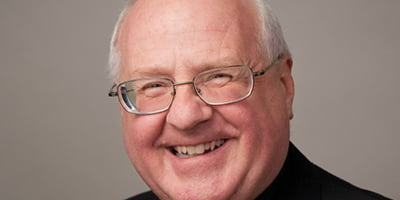
Father Mark Goldasich is the pastor of Sacred Heart parish in Tonganoxie. he has been editor of the Leaven since 1989.
by Father Mark Goldasich
File this under things that you never knew about God:
Little Bobby and his grandmother were looking at some vacation pictures.
The scenes were breathtaking, each more beautiful than the one before.
“It looks just like an artist painted this scenery,” said Grandma. “Do you know God painted it all for you, Bobby?”
“Yes,” answered Bobby. “God did it with his left hand.”
This confused Grandma a bit, so she asked, “What makes you say God did this with his left hand?”
“Well,” said Bobby, “Father said at church last week that Jesus sits on God’s right hand.”
All kidding aside, my attention this past week has been directed, oddly enough, toward art . . . and penitence. Let me get the “confession” part of this out of the way first.
Last Christmas, I read a review — complete with several pictures — about an art book that really grabbed my attention. I clipped the article and popped it in my “maybe buy later” folder. I might have forgotten all about it had
we not done an article in the March 16 Leaven about parishioners from Curé of Ars touring the Nelson-Atkins Museum of Art in Kansas City, Mo. That piece reminded me of that “potentially neat” art book in my files. Long story short,
I ended up ordering the book from Amazon, even though it cost (gulp) over $100.
When it arrived last week, I realized that apologies were in order to at least three people: the person who shipped the book, the UPS delivery person, and Anita McSorley, managing editor at The Leaven who brought the book from the front desk of the chancery to my office. I guess I’d sort of underestimated the size of the book. It’s a whopper: 17 1⁄2 inches tall and 11 1⁄2 inches wide. It’s also 3 inches deep to accommodate its 800 pages. Uh, and it’s kind of heavy, too: somewhere in the neighborhood of 23 pounds. So, to all who lugged that tome to me: Thanks, and I’m sorry. I knew that it was a coffee-table type of book; little did I realize that it was big enough to actually be a coffee table!
The book, by the way, is “Ars Sacra” (h.f. ullmann, 2011). Its subtitle explains why it’s so huge: “Christian Art and Architecture of the Western World — from the very beginning up until today.” Sometimes the reproductions of pieces of art in books are so tiny that you can barely make them out. You can’t say that about this volume: The details — from paintings to mosaics to sculpture to church buildings — leap off the page with stunning clarity. This is not a book to be read; it’s more a museum to be savored.
It’s fascinating to see the various ways that Jesus, Mary, the saints and scenes from the Bible are rendered.
The “sternness” and otherworldliness of Jesus depicted in mosaics or icons contrasts with the vulnerability and humanness of Jesus found, for example, in Peter Paul Rubens’ “Deposition,” which shows the body of Jesus being taken down from the cross.
I bring all of this up, not to encourage you to rush out and buy this book (although it’s worth every cent), but to suggest a possible way to pray as you journey through Holy Week. Naturally, you can’t do better than to attend the Triduum celebrations. You can check out our four-page guide to these special liturgies in this issue to prepare yourself.
But Holy Week is also a time for intensive personal prayer, a time to step back temporarily from our usual daily cares and concerns. Stepping back, however, is harder than it should be. When we try to quiet ourselves, we become conscious of just how noisy our world is — not only on the outside, but inside our minds as well. And that’s where sacred art can help. Looking at
a stained-glass window or a painting helps us to focus, calm the chaos and regain God’s perspective on life.
Art can make God more accessible to us. The third-century theologian Origen put it this way. He asked people to imagine a village with a statue that was so huge that no one could see exactly what it was supposed to represent. Finally, someone miniaturized the statue so everyone could see the person it honored. Origen concluded, “That is what God did in his Son.” (Found in “Perfect Illustrations for Every Topic and Occasion,” by Craig Brian Larson and Drew Zahn.)
This Holy Week, ponder the crucifix on your wall or rosary, hold onto a holy card, or cradle a statue or icon in your hands. Or head to your local museum, library, bookstore or online and let some sacred art inspire you and give you a fresh glimpse of Jesus, our savior, the human face of God.


